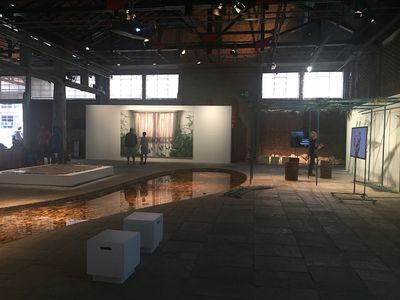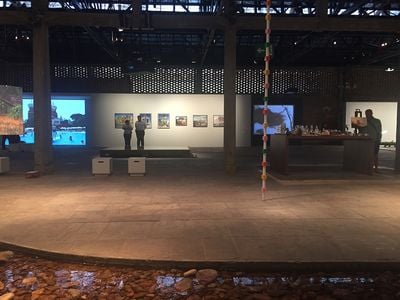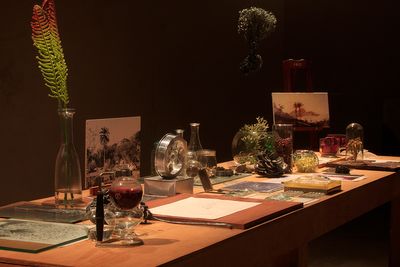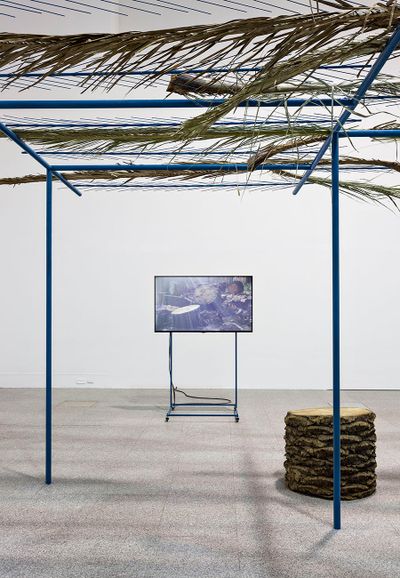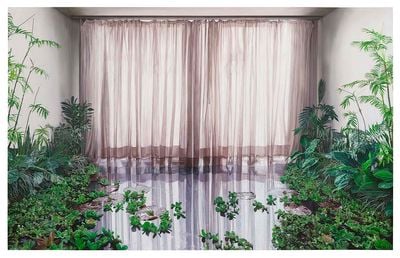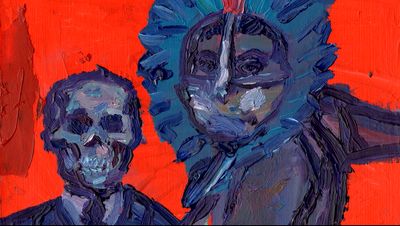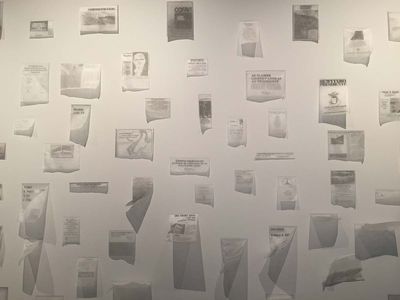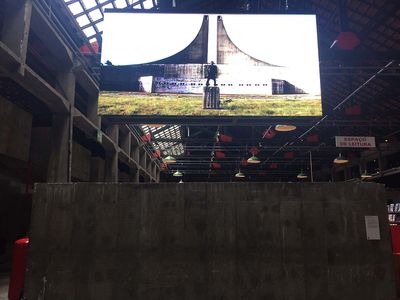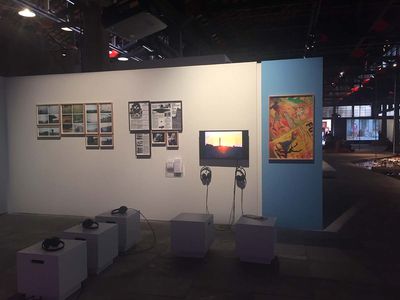Southern Panoramas: 20th Contemporary Art Festival Sesc_Videobrasil
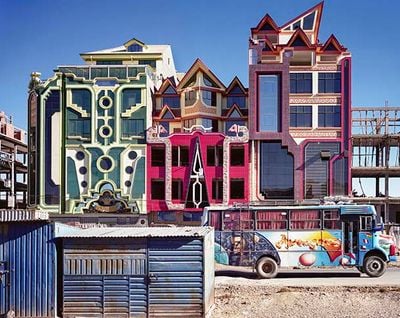
Tatewaki Nio, Neo-Andina #102 from the series 'Neo-andina' (2016). Courtesy the artist and Sesc_Videobrasil.
Instability has become a constant in the world today, with disputes and crises (ecological, political and cultural) revealing the urgent need to challenge current dynamics of power and reshape the outdated structures and systems that have organised societies in recent history. In this moment of flux, the 20th Contemporary Art Festival Sesc_Videobrasil in São Paulo (3 October 2017–14 January 2018) presents a range of works—including installations, video, performances, sculptures, objects and paintings—by 50 artists from 25 countries throughout Latin America, Africa, Asia and the Middle East.
The festival's subtitle, Southern Panoramas, is representative of an ideological and symbolic geopolitical South: a southern axis that Videobrasil developed in the 1990s and has further emphasised since 2011. This geopolitical perspective includes not only countries located south of the Equator, but those that can be understood as 'southern' in terms of their relation to historical North-South global power dynamics.
Works on view were selected by a curatorial team led by Solange Farkas, from submissions to an open call that generated applications from nearly 2000 artists from 109 countries. The curatorial premise—which considers art for unstable times from a southern perspective—grew out of analysing and identifying common threads within these submissions.
Installed in one of São Paulo's most forward-thinking institutions and striking venues, Sesc Pompéia (an old tambourine factory with several warehouses converted into a leisure centre by architect Lina Bo Bardi in the early 1980s), the show was organised according to six intertwined conceptual clusters: 'Cosmovisions', 'Ecologies', 'Reinvention of Culture', 'Politics of Resistance', 'Invisible Stories' and 'Other Modernisms'.
Yet, despite there being specific curatorial themes, there is no clear visual communication of these thematic groups in the exhibition itself—a reminder that curating (and why not, living) isn't an exact science, nor can it be neatly organised into independent categorisations.
As noted in a text by guest curators Ana Pato, Beatriz Lemos, Diego Matos and João Laia (all Brazilian aside from the latter, who is Portuguese), a 'theory of constellations' inspired the curatorial concept as a whole, with selected works evoking 'the organisation of words and concepts in the cloud of a recognisable and integrated vocabulary'.
The show occupies outdoor and indoor common areas of the warehouses at Sesc Pompéia, as well as a cinema/auditorium that was purpose-built for the show in one of the warehouses on the premises, where most of the artworks are also exhibited. In a different area of that same building, where a permanent water feature sinuously slices the concrete floor, one theme that emerges is the relationship between man and nature.
The futuristic garden installation Lost Heritage (2015) by Lithuanian duo Pakui Hardware is an eerie scene of anamorphic, organic-looking silicon sculptures laid on three slabs of grass flanked by LED light fixtures and a central mechanised spray system that periodically juts red liquid at bare white walls.
Next to this, Miguel Penha draws on his personal search of his Brazilian-indigenous heritage to inform two, large tropical jungle acrylic on canvas paintings, Cipó (Vine) (2016) and Cipó azul (Blue vine) (2014), in which monumental vegetation is depicted in subtly unusual palettes (such as red for a vine, blue and green for some tree trunks), with little or no trace of man and animals.
Nature as the keeper or source of information is also a theme in Débora Mazloum's installation Jardim de Aclimatação XXI (Acclimatisation Garden XXI) (2015): a table covered with small botanical drawings and landscape paintings, microscopes and samples of earth, stones, berries, dried leaves and artificial plants held in glass vesicles, among other things. These items all come together as a reminder of man's impulse to attain, collect and control information, as well as nature.
The Current Situation (2015), by Portuguese artist Pedro Barateiro, is a deeply moving video-installation that addresses current crises by building an interrelated narrative on nature, science, culture and politics from excerpts of text, image and sound. The piece is composed of two LCD screens, one at either end of the installation and stumps of palm trunks and a canopy of palm leaves that creates a connecting element between the screens.
One LCD set shows a video and sound of an ancient palm tree (endemic to former Portuguese colonies in Africa) being cut-down because it is afflicted by disease; the voice-over emitted by the two-channel sound system is a recording of a protest statement against austere demands made by the EU to southern European countries deemed responsible for the economic crisis. These different realities fuse fluidly to create a new one in the video.
The other LCD screen, which has no sound, shows a series of short texts under the heading 'The Current Situation (Prologue)'. One quotes a text by The Economist magazine's obituaries editor, Ann Wroe, published in the special edition 'The World in 2015': 'Ordinary people should not want to escape. Man is a social being ... To opt out, into solitude or silence, was a choice that often seemed bizarre and had to be explained'. Another quotes definitions from Merriam Webster's Word of the Year in 2014, culture, which included an interpretation of culture's main trait as an 'adaptive mechanism'.
Neighbouring Barateiro's installation is Brazilian painter Ana Elisa Egreja's hyper-realistic large-scale painting, Poça II / Sala de jantar (Puddle II / Dining room) from the series 'Jacarezinho 92' (2017). Rendered in oil on canvas it depicts a staged interior scene painted from a photograph the artist took of a room with closed floor-to-ceiling curtains, in her grandmother's former residence, which the artist flooded and filled with tropical aquatic plants and frogs.
The painting weaves together the concept of nature with that of the domestic space, questioning expectations of indoor and outdoor environments, of reality and art.
Artworks like these are a few examples in this exhibition that speak to the power of destabilising narratives and presumed natural orders. By depicting nature as something fragmented, studied and depicted, or by highlighting how society deals with ailment and fragility both on a natural and manmade scale, what is brought to the surface are the different relations between distinct visualisations of what the curators identify as 'particular and general, minimum and whole, certainty and imprecision, art and science'.
Worth mentioning are a few striking pieces that speak to the politics of resistance. Not surprisingly, given the political climate in Brazil, a number of local artists stand out (15 Brazilian artists in total are in the show).
Thiago Martins de Mello presents an exquisite animation titled bárbara balaclava (2016): a sequence of images, made up of over 4000 brightly coloured paintings and drawings depicting quickly alternating and integrated scenes of native Brazilian Indians, colonisers, women being raped, genitalia, beheaded figures, animals and nature settings, to mention a few images. These create a narrative that references the violence and repression of minorities that has shaped Brazil's history and the cultural tensions that still exist today.
Jaime Lauriano offers another historical view by highlighting oppressive mechanisms of power, from the institutions of law enforcement and border control, to the narratives that both define and impose hierarchies. In the video, O Brasil (2014), Lauriano exposes the marketing tactics used in the 1960s by the military dictatorship in power at the time to promote the image of a peaceful and homogenous country. An antique TV screen shows a series of clips from historic TV advertisements announcing slogans for a happy nation interspersed with newspaper clippings denouncing facts, in a shocking collage of opposing narratives.
The themes of heritage, memory and Brazil's past dictatorship are also in focus in Rafael Pagatini's Bem-vindo presidente! (Welcome President!) (2016), which is composed of sheets of tracing paper depicting newspaper advertisements from the 1960s to 1980s, which tie the military dictatorship to the private business sector. The rectangular white sheets in different sizes are pinned from their top corners onto a long white wall leaving their bottom halves loose to rustle in the breeze, in an evocative and poetic reminder of how memories seem to fade away with time.
Politics was, of course, also a hot topic for artists of other nationalities. Of Nationhood (2015) is a video by South African artist Thando Mama, in which a black man explores the imposing but abandoned concrete monument, Ntaba ka Ndoda. Erected in the 1980s, the structure celebrates Ciskei, a country created and dissolved in territorial wars that established the South African state borders.
Shown on an LCD screen hung high by Sesc Pompéia's library, it blends well with the building's architectural brutalism. The relations between politics and architecture are also explored in other works, including four tapestries hung in pairs on two opposite walls from the 'Mezquitas de Puerto Rico – Hatillo' ('Mosques of Puerto Rico – Hatillo') series (2014–2015), by Kuwaiti artist Alia Farid in partnership with Jesús 'Bubu' Negrón.
Gesturing towards migratory and cultural tensions and the role of architecture and urban spaces in transmitting (as well as creating) cultural signs, symbols and customs, the tapestries were created from pictures of buildings taken in Puerto Rico and the Dominican Republic that the artists sent to Iranian weavers. Three of the four exhibited tapestries depict buildings resembling mosques that blend architectural styles, with all tapestries featuring borders that mix Central American and Iranian ornamental designs and motifs.
In his series 'Neo-Andina' (2016), Japanese photographer Tatewaki Nio focuses on a new Bolivian architectural phenomenon, the cholets: colourful and sumptuous buildings erected on the periphery of La Paz by the recently economically ascended Aymara indigenous population. Celebrating a revived and updated Andean pride in chola culture, these buildings serve as monuments to the political and cultural changes the country has been going through in recent years, which is shaping a new urbanscape.
Offering an antithesis to what Nio found in Bolivia is Copacul lui Gagarin (2016) by Romanian artist Mona Vatamanu and Swiss artist Florin Tudor: one of the dozens of videos that filled an audio-visual programme exhibited exclusively in the purpose-built cinema. Guided by the Romanian philosopher Ovidiu Tichindeleanu, the video shows the abandoned buildings and ruins of the Gagarin Youth Center in Moldova—traces of utopian socialist dreams of conquest into space and futures that never arrived.
The fascination with outer space and exploring narratives-as-constructs also permeate Brazilian artist Mabe Bethônico's contribution, Histórias Minerais Extraordinárias (2016), a series of talks and debates open to the public inspired by the lives of three Swiss scientists (geographer Aubert de la Rüe and ufologists Billy Meier and Pierre Versins). These encounters take place in the main warehouse where the artist has displayed archival videos, photographs and photocopies related to UFOs and geological findings. The role of narrative in relation to the cosmos also guides Peruvian artist Elizabeth Vásquez Arbulú's video-installation that tells the story of the universe from creation to today using images from catechism picture books of the 1970s and 1980s.
Moving from the micro to the macro fluidly, and across cultures, narratives, practices, disciplines, textures, landscapes and even dimensions, the 20th Sesc_Videobrasil navigates and manages different scales with impressive agility.
Rather than exploring the instability of our times with a sense of foreboding or from a singular position, the exhibition frames the present moment as a series of overlapping perspectives that shine a light on the need to look beyond ordinary hegemonies to establish new orders and seek out different routes towards possible futures.—[O]

